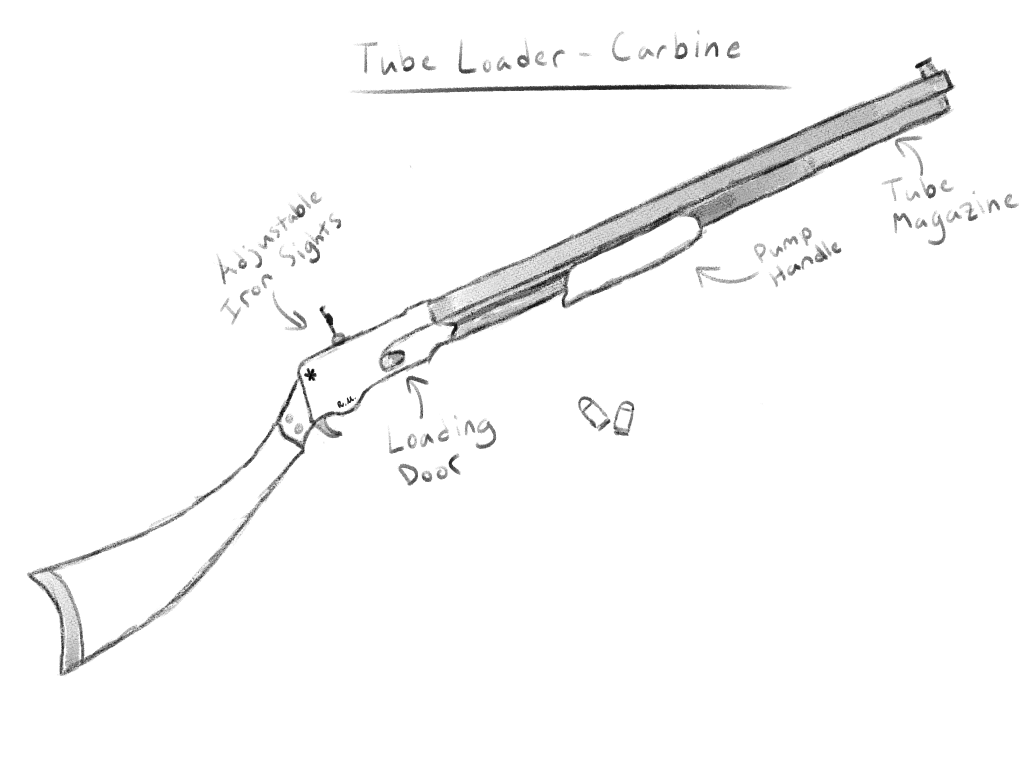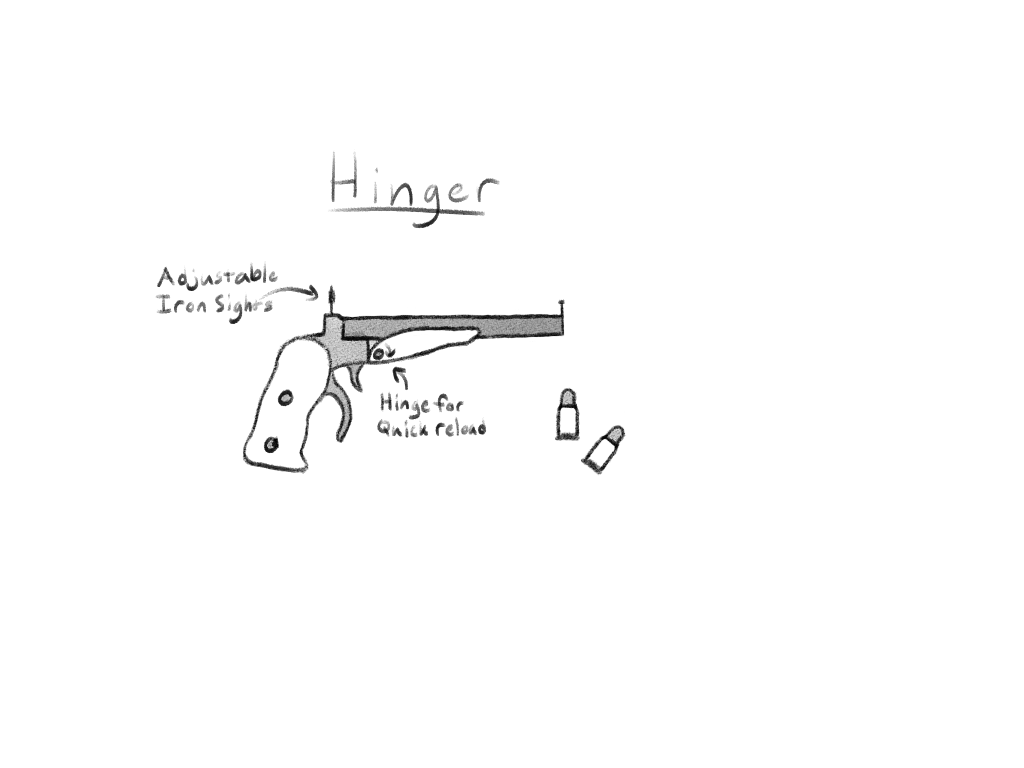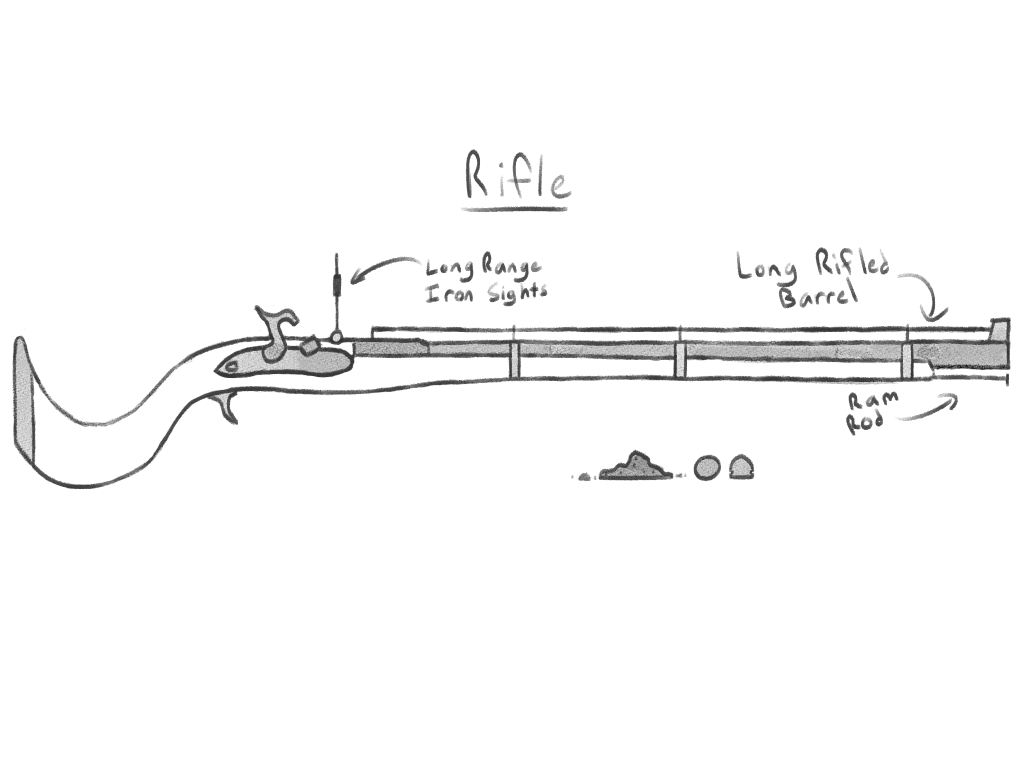Order of Iron Firearms Guide V1.0
A Firearms Supplement for 5th Edition D&D
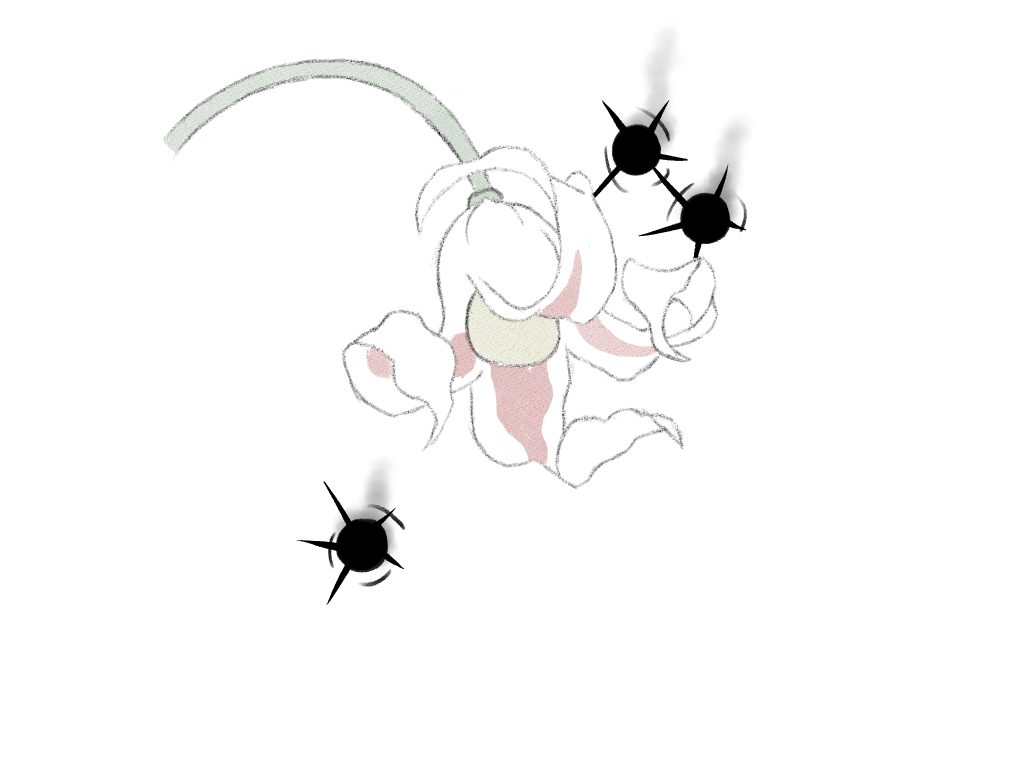
Art by Dan O'Reilly
Order of Iron Firearms Guide v1.0
Firearms
The Order of Iron are the only group in the Civilized World who have the skills and knowledge required to create firearms, weapons of fire and steel, the likes of which could be mistaken for magic by lesser minds. Firearms are powerful weapons, but have certain limitations due to their complexity and experimental nature.
In the right hands, firearms can prove to be exceptional alternatives to traditional weaponry.
Firearms Proficiency
There are a plethora of different firearms categorized by the Order of Iron. Due to the vast diversity in these weapons, firearms are typically organized by loading method and form. Given the lack of standardization in firearms training, a typical proficiency will usually include all of the firearms of one weapon class.
Firearm Proficiencies:
Muzzle Loaders - All firearms with the ML Property
Handguns - All firearms of the Handgun classification
Carbines - All firearms of the Carbine classification
Long Guns - All firearms of the Long Gun classification
Scatterguns - All firearms of the scattergun classification
Any creature who is not proficient in the use of a firearm makes all attacks with that weapon at disadvantage and automatically misses any attacks that would be made at disadvantage for any other reason. If the weapon instead forces the target to make a saving throw, all targets have advantage on the roll and take no damage on a success.
Loading Method
The first aspect of a firearm that is used to categorize it is its loading method. This also dictates what kind of ammunition it uses. All firearms are either Muzzle Loaders or Cartridge Loaders.
Muzzle Loaders (ML) are loaded via the end of the barrel with loose powder and shot. Muzzle Loaders tend to be simpler, slower, and harder hitting than Cartridge Loaders.
Cartridge Loaders (CL) are loaded with cartridges, which are self contained pieces of ammunition that have the powder, bullet, and primer in a single casing. Cartridge Loaders tend to be more complicated, quicker to load, and have greater ammunition capacity than Muzzle Loaders.
Weapon Class
The second way in which firearms are categorized are by Firearm Classification. Firearms are classified as Handguns, Carbines, Long Guns, and Scatterguns.
Handguns are light firearms small enough to be wielded in one hand, although a free hand is needed when loading. They are adaptable weapons that excel in close quarters. They are also quick to draw, which most firearms are not, and they can all be stored loaded, including muzzle loader handguns.
Carbines are light firearms that are useful in a multitude of settings, sporting a respectable effective range. Although they are not as efficient in close range as handguns, Carbines have a far superior effective range, pack more of a punch, and tend to have a larger ammunition capacity.
Long Guns are heavier firearms used by careful specialists. These weapons sacrifice short range and defensive effectiveness for unmatched heavy hitting, long range capability. Long Guns are typically limited in range by the vision of the wielder.
Scatterguns are unique and highly varied firearms which can prove devastating to groups of targets at short range. Having an even shorter range than most Handguns, Scatterguns can fire several projectiles at once in an area in front of the wielder.
Firearm Properties
Order of Iron weapons possess some similarities to their more archaic and simplistic counterparts, but due to the nature of their function, firearms have more properties in addition to the weapon properties in the PHB.
Attack rolls made with firearms are considered ranged attacks and follow the rules in the PHB under "Ranged Attacks in Close Combat."
Universal Firearm Properties
Some properties are universal (unless otherwise stated) to firearms.
Firearm Loading. All firearms must be loaded if their internal capacity has been depleted in order to fire. The wielder can also choose to load a partially empty weapon. If a character has the ability to make more than one attack with their action, they may substitute one of their attacks with a load action. All firearms require a free hand, or for both hands to be used for the weapon, to be loaded. All loading actions load one piece of ammunition per action, unless there is a number greater than one listed on the table on page 3 in the "Load" column, in which case the loading action loads as many as that many pieces of ammunition. Firearms cannot have more ammunition loaded at any one time than is listed in the "Capacity" column on page 3. Making an attack with a firearm uses up one piece of loaded ammunition.

Firearm Ammunition. Like the ranged weapons in the PHB, firearms require ammunition to fire, however, no ammunition fired from a gun can be recovered and some firearms can contain more than one piece of ammunition.
Cumbersome. Most firearms are not easily stored on the body, all firearms lacking the quick property cost an action to draw or stow and cannot be stowed loaded. If a character can make more than one attack with their action, such as in the case of the "Extra Attack" feature, then they can replace one of their attack actions to draw or stow a firearm with this property.
Misfire. Firearms are powerful, but at times unreliable weapons. If an attack roll is made, and the number rolled on the d20 is equal to or less than the weapon's misfire range, then the character must roll on the misfire table. The misfire range of each weapon is listed in the "Misfire" column on the table on page 3.
Jammed. A weapon might become jammed if it misfires. A jammed weapon cannot be fired or loaded. A character may spend an action to attempt to unjam the weapon by performing a Dexterity (tinker's tools) check (DC 10 + misfire range). On a success the weapon becomes unjammed and can be used again as normal. On a failure the firearm is broken. The check is automatically passed if a character spends thirty seconds outside of combat unjamming the weapon with a set of tinker's tools.
Broken. A broken firearm is unusable. In order to repair a broken weapon, a character must spend the firearm's misfire range x 100gp and misfire range x2 hours of work. The character repairing the firearm must be proficient in the use of that firearm and have a minimum of a 11 + misfire range Intelligence score.
Other Firearm Properties
Due to the wide diversity of firearms, some have other, unique properties.
Rapid. Whenever you would make a ranged attack with this weapon, you may make a second attack against the same target immediately. This effect does not stack with extra attack.
Weighty. This weapon is large and cumbersome, even by firearm standards. A wielder with less than 13 Strength has their movement speed reduced by 5 while this weapon is equipped.
Long. Long Guns are capable of hitting targets accurately from exceptionally long distances, however, weapons of precision like these fail to hold up in close quarters. Attacks against targets within 30 feet are made at disadvantage.
Scattershot. Scatterguns do not require the wielder to make any attack rolls. Instead an attack made with a scattergun simply deals damage to targets in an area in front of the wielder. Firing a Scattergun requires the wielder to roll a d20 to misfire before any targets are affected, this roll only determines whether or not the weapon misfires. All targets in the attack area must make a Dexterity saving throw with a DC equal to 8 + the wielder's Dexterity or Strength modifier + the wielder's proficiency bonus. On a failure, the target takes the weapon's rolled damage, on a success, the target takes half of the rolled damage. Weapons with the Scattershot property deal an extra die of damage to targets within 5 feet of the wielder (the target can still half this damage by succeeding the saving throw).
Recoil. The massive force involved in firing this weapon has the potential to send the wielder sprawling. If the wielder has less than 14 Strength, when this weapon is fired, the wielder must make a DC 11 Strength saving throw, on a failure, the wielder is knocked 5 feet back and prone.
Nimble You can spend a bonus action to load one piece of ammunition into this weapon.
Quick. This firearm can be more easily stowed and drawn than other firearms. This firearm can be stowed loaded and drawn or stowed with an object interaction.
Classification Properties
Some properties are present in all firearms of a specific classification. These properties are also listed in the table on page 3.
Handguns Properties - Quick, light
Carbine Properties - Two-handed
Long Gun Properties - Two-handed, heavy, long
Scattergun Properties - Two-handed, scattershot
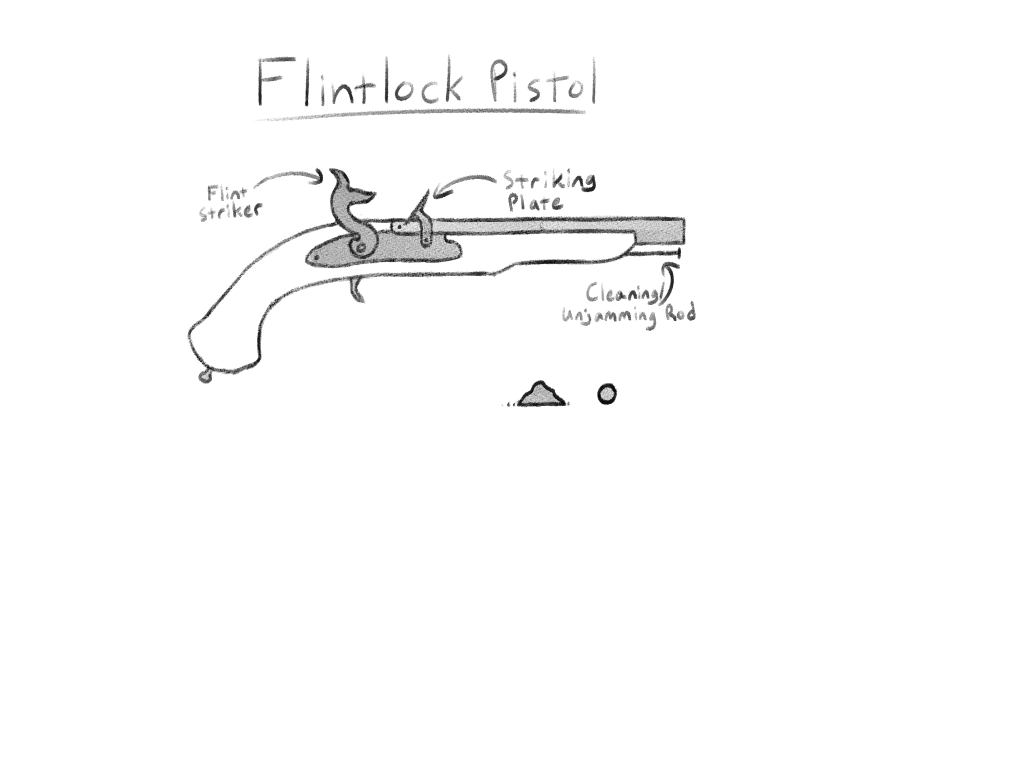
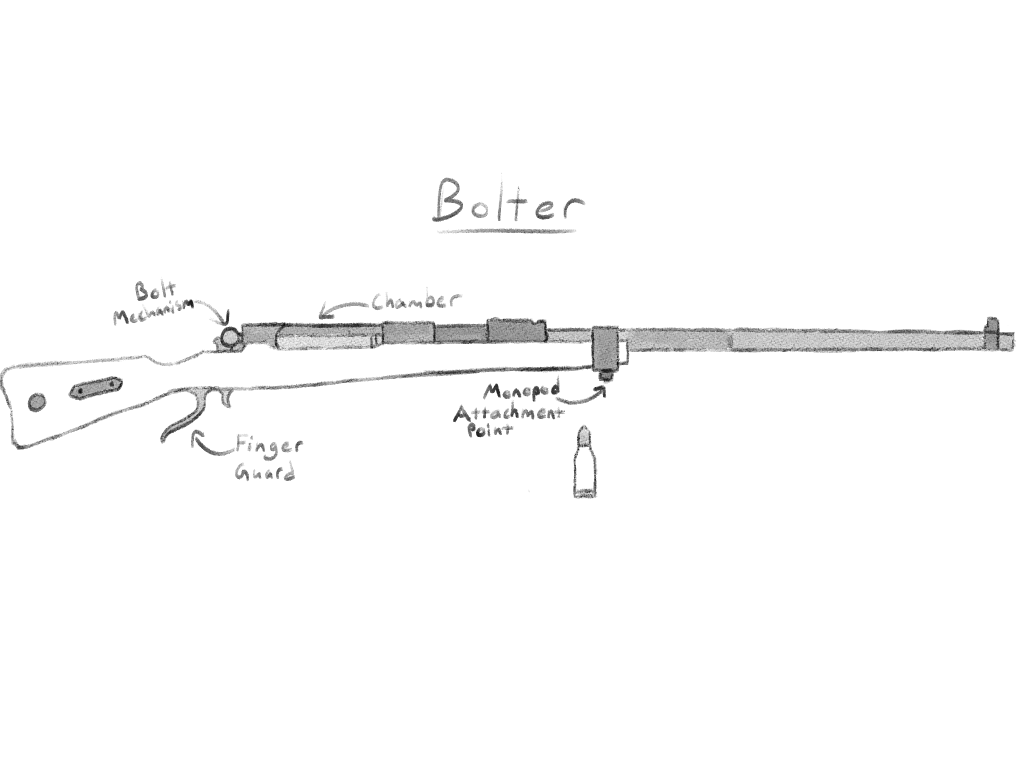
Firearms
| Name | Damage | Weight | Range | Misfire | Capacity | Load | Properties |
|---|---|---|---|---|---|---|---|
| Handguns | Light, quick | ||||||
| Flintlock Pistol | 2d6 bludgeoning | 2 lb. | 40/120 | 1 | 1 | 1 | ML, finesse |
| Rotator | 1d8 Piercing | 3 lb. | 40/120 | 2 | 6 | 2 | CL, finesse |
| Hinger | 1d10 piercing | 4 lb. | 80/240 | 2 | 1 | 1 | CL, nimble, finesse |
| Stack Loader | 1d6 piercing | 5 lb. | 40/120 | 4 | 8 | 4 | CL, rapid |
| Carbines | Two-Handed | ||||||
| Short Musket | 2d8 bludgeoning | 7 lb. | 60/240 | 1 | 1 | 1 | ML |
| Rotator-C | 1d10 piercing | 9 lb. | 80/320 | 2 | 5 | 2 | CL |
| Bolter-C | 1d12 piercing | 8 lb. | 120/480 | 2 | 1 | 1 | CL, nimble, long |
| Tube Loader-C | 1d10 piercing | 11 lb. | 80/320 | 4 | 7 | 3 | CL, nimble |
| Long Guns | Two-Handed, heavy, long | ||||||
| Musket | 2d10 bludgeoning | 7 lb. | 120/480 | 1 | 1 | 1 | ML |
| Rifle | 2d10 piercing | 15 lb. | 250/1000 | 1 | 1 | 1 | ML, weighty |
| Bolter | 2d8 piercing | 16 lb. | 250/1000 | 2 | 1 | 1 | CL, nimble, weighty |
| Chamber Bolter | 2d8 piercing | 18 lb. | 250/1000 | 4 | 4 | 2 | CL, nimble, weighty |
| Scatterguns | Two-Handed, scattershot | ||||||
| Fodder Loader | 2d6 bludgeoning | 21 lb. | 10 by 30 ft. line | 2 | 1 | 1 | ML, heavy, recoil, weighty |
| Hand Cannon | 2d8 bludgeoning | 19 lb. | 10 by 30 ft. line | 3 | 1 | 1 | ML, heavy, recoil, weighty |
| Break Back | 1d8 bludgeoning | 17 lb | 5 by 20 ft. line | 2 | 2 | 2 | CL, weighty |
| Tube Loader | 1d8 bludgeoning | 18 lb | 5 by 20 ft. line | 3 | 5 | 2 | CL, weighty, nimble |
Firearm Ammunition
What's a gun without bullets besides a fancy club?
Generally speaking, ammunition falls into one of two schools of thought: loose shot or cartridges. Besides that, different classes of firearm take different sizes of ammunition, but a crafty gunman can reshape similar ammunition to fit most roles. As a result, there are only 5 kinds of ammunition.
All firearm ammunition requires the acquisition and careful treatment of the "Cornis Flower" into an explosive powder. The Cornis Flower is notoriously finicky and hard to grow. It is only believed to naturally grow in the high altitude environment near the Order of Iron citadel. As a result, the creation of explosive powder requires the cooperation of master botanists and proficient gun smiths.
Loose Shot. Composed of a single ball or minié ball and loose powder. Non scattergun muzzle loaders fire Loose Shot.
Cartridges. A self contained unit of ammunition, the cartridge contains the powder, bullet, and primer. Handgun and Carbine cartridge loaders fire cartridges.
Rifle Cartridges. A sized up, pointed version of their smaller cartridge brethren. Rifle Cartridges are fired by cartridge loader Long Guns.
Scatter Shards. A pile of projectiles and a pile of powder, doesn't get any simpler than that. Scatter Shards are fired by muzzle loading Scatterguns.
Scatter Cartridges. A more sophisticated approach to close quarters annihilation, Scatter Cartridges contain a primer, powder and a handful of projectiles. Scatter Cartridges are fired by cartridge loader Scatterguns.
Ammunition
| Name | Cost per 10 pieces of ammuntion |
|---|---|
| Loose Shot | 3gp |
| Cartridges | 4gp |
| Rifle Cartridges | 15gp |
| Scatter Shards | 5gp |
| Scatter Cartridges | 6gp |
Misfires
When an attack is made with a firearm, and the number on the d20 is equal to or less than the misfire range of the weapon, the weapon misfires. Most of the time a misfire will only result in a miss, but misfires can also cause a weapon to destroy loaded ammo, become jammed, or even break. When a weapon misfires, roll on the misfire table to determine the exact nature of the misfire.
The likelyhood of a misfire taking place is based on the complexity of the weapon. The misfire range is listed on the table on page 3 in the "Misfire" column.
| Misfire Roll | Result |
|---|---|
| 20 | Automatic miss/save |
| 19 | Automatic miss/save |
| 18 | Automatic miss/save |
| 17 | Automatic miss/save |
| 16 | Automatic miss/save |
| 15 | Automatic miss/save |
| 14 | Automatic miss/save |
| 13 | Automatic miss/save |
| 12 | Automatic miss/save |
| 11 | Automatic miss/save |
| 10 | Automatic miss/save |
| 9 | Automatic miss/save + Loaded ammunition wasted |
| 8 | Automatic miss/save + Loaded ammunition wasted |
| 7 | Automatic miss/save + Loaded ammunition wasted |
| 6 | Automatic miss/save + Loaded ammunition wasted |
| 5 | Automatic miss/save + Loaded ammunition wasted |
| 4 | Automatic miss/save + Loaded ammunition wasted |
| 3 | Automatic miss/save + Loaded ammunition wasted + Jammed |
| 2 | Automatic miss/save + Loaded ammunition wasted + Jammed |
| 1 | Automatic miss/save + Loaded ammunition wasted + Broken |
Firearm Crafting
The Order of Iron jealously guards the secrets of firearm crafting, believing others to be unfit to possess such knowledge. As a result it would be exceedingly rare to find someone that possessed both the secrets of crafting firearms and a willingness to share that knowledge. As a result there are currently no rules governing the crafting of new firearms. Depending on what the future holds a further supplement may be made that includes comprehensive crafting rules.
Crafting Ammunition
Depending upon the setting, a character may not be able to easily purchase ammunition. A character may craft ammunition for weapons with which they are proficient. They may do so at 1/2 of the cost of purchasing the ammunition. It takes twenty minutes of work per cartridge, and ten minutes per charge of loose shot or pile of scatter shards. The availability of materials required to make the ammunition may affect the cost and time required.
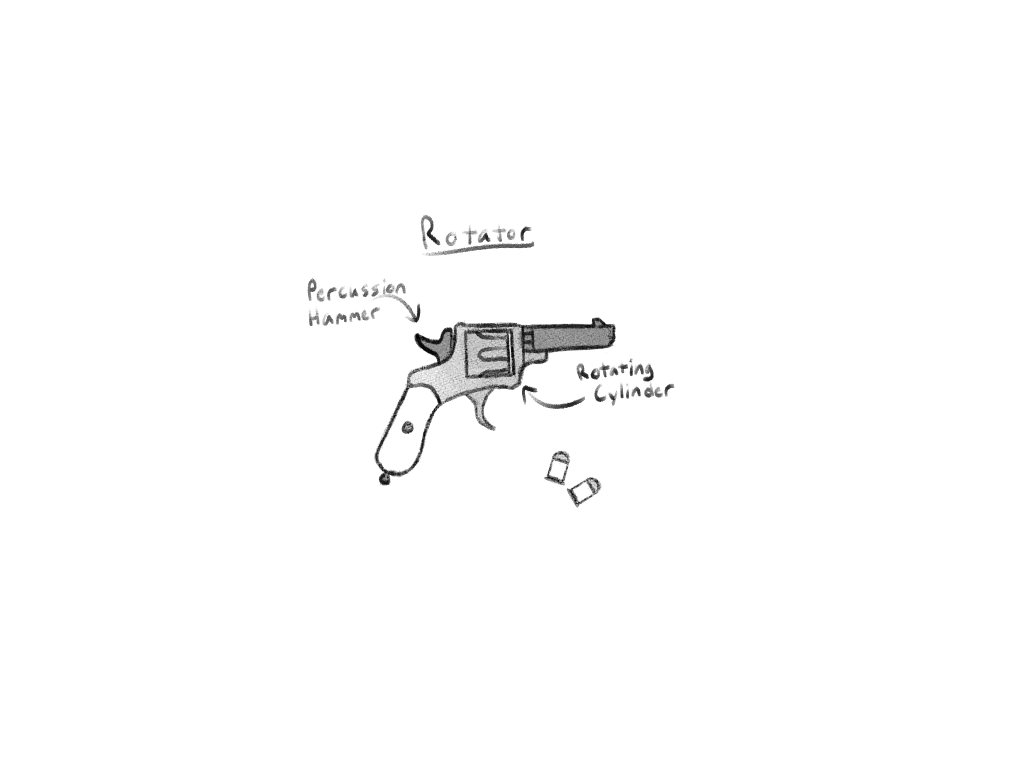
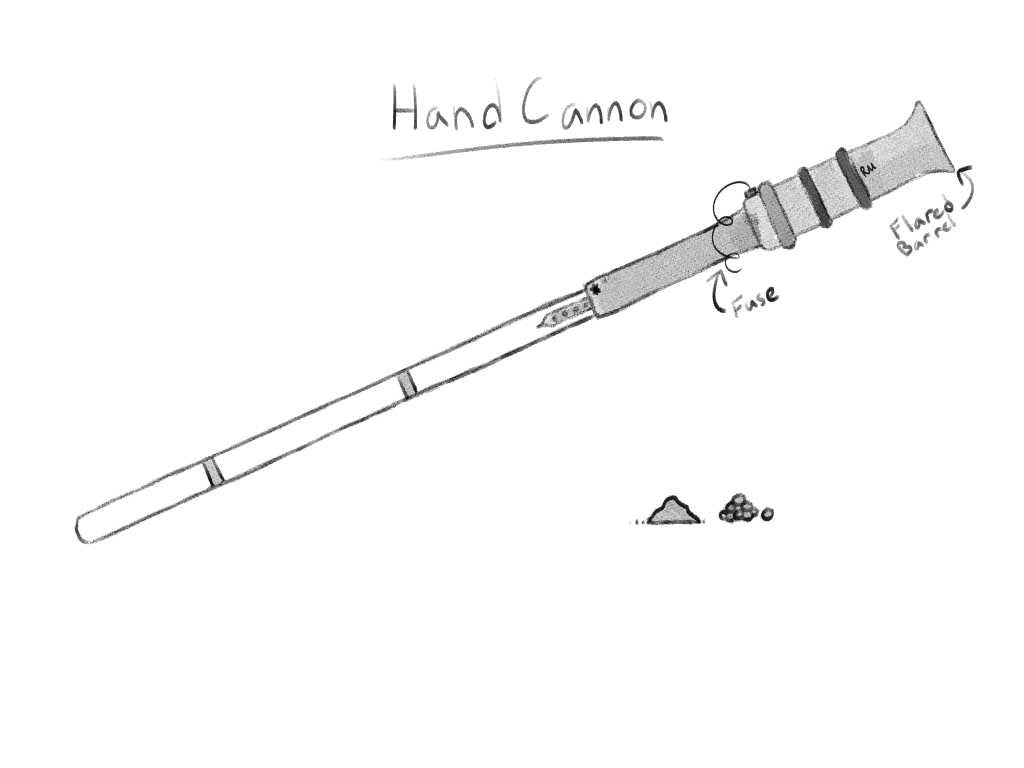
Firearm Feats
Firearms are no simple cudgels or pointed sticks, it takes time, dedication, and sacrifice to become proficient in their use. That is, if you can find someone to teach you...
All firearm feats require that a character have access to a willing teacher. This ability to take firearms feats is up to the DM's discretion.

Gunman
A competent shooter by all accounts, you gain the following benefits.
- Increase your Strength or Dexterity score by 1, to a maximum of 20.
- You gain proficiency with 2 firearm classes of your choice.
- You gain proficiency with tinker's tools.
Maintenance Specialist
Prerequisite: Proficiency with tinker's tools and at least 1 firearm
You are one with your weapon, you know it inside and out, your firearms very rarely fail you. You gain the following benefits.
- Whenever your weapon misfires, you gain advantage on the misfire table roll.
- Whenever you attempt to unjam a firearm, you have advantage on the tinkers tool's check.
- When repairing a broken firearm, you may do so at half the normal repair cost and in half the normal time.
- You gain expertise with tinker's tools.
Akimbo
Prerequisite: Dexterity 13 or higher, proficiency with Handguns.
Float like a butterfly, sting like a bee, hopefully well out of reach of those savages' sharp sticks... You gain the following benefits.
- You can draw or stow two handguns when you would normally be able to draw or stow only one.
- You can load Handguns without having a free hand.
- When you use the attack action with a handgun, you can use a bonus action to attack with another handgun in your other hand.
Gun Kata
Prerequisite: Strength 13 or higher, proficiency with Handguns.
To say that your gun is an extension of you would be a severe understatement, death flows from your hand as easily as breath from the lungs. You do not fear close quarters as other ranged attackers do, you relish it, use it to your advantage. You gain the following benefits.
- Making a ranged attack with a handgun while a hostile creature is within 5 feet does not impose disadvantage on the attack.
- While wielding a handgun, you may make opportunity attacks against creatures that leave your melee range with your handgun.
- While you have a free hand and are wielding a Handgun, as a bonus action you may try to shove a creature within 5 feet of you.
Calculated Shooter
Prerequisite: Intelligence 13 or higher, proficiency with Long Guns.
There is no problem that cannot be solved with a really long range rifle and a little ingenuity. At least, if you consider a problem "solved" when it lies motionless with a neat new hole in its heart. You gain the following benefits.
- You gain proficiency with cartographer's tools.
- When you hit a target with a carbine or long gun, you may add your Proficiency Bonus to the damage of the attack. You can do this a number of times equal to your Intelligence modifier (minimum of once). You regain all expended uses after a long rest.
- If you have cartogtapher's tools and you spend one minute prone with your long gun equipped with a target in sight and in your long gun's normal or long range, at the end of the minute, you may make a Special calculated Attack against that target. Make an Intelligence (cartographer's Tools) check (DC 10 for a target within normal range, DC 12 at long range). If you succeed the check, you hit the target, you deal your weapon's normal damage plus additional damage equal to your level. If you have the Sneak Attack feature, you may add your Sneak Attack damage to the damage of the calculated Attack.
Blowback
Prerequisite: Strength 13 or higher, proficiency with Scatterguns
Ha! Those pansies and their "recommended safe powder loads," forget that, you're stronger than all of these eggheads put together and "safe" isn't in your vocabulary. You are able to load your scattergun shells with more powder and can handle the increased recoil. You gain the following benefits.
- You may choose to benefit from any of the following effects before the misfire check is rolled. If you choose to benefit from these effects, your weapon's misfire range increases by 1 for each effect.
- You may add your Strength modifier to the damage of attacks made with scatterguns.
- Any creature that fails the saving throw against attacks made with a Scattergun is pushed back 5 feet.
Fante
Prerequisite: Dexterity 13 or higher, proficiency with Carbines
Some people say that carbines are for grunts and the unspecialized, well quite frankly, not everyone needs to be special. Sometimes, you just need a reliable, tough bastard like you, and an equally reliable, tough gun. You gain the following benefits.
- All carbines gain the Quick property for you.
- Reduce the misfire range of all Carbines that you use by 1 (minimum 1).
- You gain a +1 bonus to ranged attack rolls made with Carbines.
